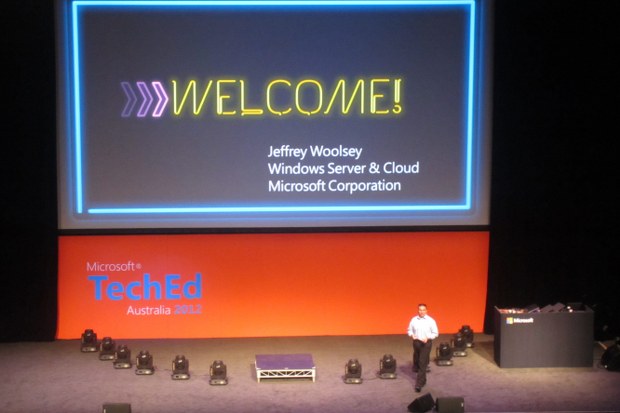The tech behind TechEd 2012

With nearly 3,000 people attending TechEd 2012 at the Gold Coast Convention Centre this year, Microsoft had to ensure that all of the technology powering the shows would be running smoothly.

(Credit: ZDNet)
Nothing puts a dampener on a conference run by a leading technology vendor like a colossal tech mess-up (which happens more often than you'd think), especially when there's a venue full of IT professionals and developers there.
Managing all of the technology behind the scenes for such a big event, according to Microsoft IT pro technical evangelist Jeff Alexander, is akin to running a small city.
The hardware and software
In terms of hardware, the server infrastructure at TechEd consists of 24 HP blades, each running 192GB of RAM and 600GB of hard disk, which are supported by HP 3Par SAN. There are 86 network switches provided by both HP and Cisco, which are the major partners for the event.
This year is the first time that Microsoft is running TechEd entirely on Windows Server 2012. Considering that the planning phase began in April, and Windows Server 2012 was released just a month ago, that presented a challenge in itself.
(Credit: ZDNet)
"We were configuring the servers well before the launch, so it was a balance of being about to get the release code and then getting a licence key for us to use it during the event," Alexander told ZDNet. "That was a bit touch and go there for a little bit."
Everything is running Hyper-V virtualisation, and the new feature in Windows Server 2012, Hyper-V replica, has already become a handy tool at TechEd.
Codify, the company in charge of the network design and engineering at the show, had to fire up a Hyper-V replica on Tuesday, after one of the blades went down due to a power surge and all the virtual machines had to be replicated to another node.
If this had happened last year, that blade would have been offline for a long time, but Hyper-V cut the recovery process time down to four minutes.
"That was pretty huge for us to be able to do that," Alexander said. "Without it, we would have been down for a lot longer."
Along with the bigger toys, Microsoft is running 200 HP notebooks and 270 small form factor desktop computers at the event. Powerboards were abundant around the convention centre. The vendor's recharge stations were rarely without a swarm of attendees charging up their devices.
Sadly, Microsoft was unable to provide the power-usage figures for the event, but one can only assume that it's through the roof.
Pertaining to all things networking
After getting feedback about the wireless access several years ago, Microsoft made it a mission to provide good network connectivity at TechEd 2012. With over 2,500 attendees all carrying a number of devices, providing a steady connection to all of them is a challenge, especially when it's in a building full of concrete.
(Credit: ZDNet)
The planning phase was critical to overcome that challenge.
Telstra provided the internal backbone of the network, supplying a 2GB connection with 1GB running in most of the rooms. The telco is supplying a 1Gbps internet service with a 500Mbps backup link.
Around 6,954 metres of cable, weighing in at 270kg, was deployed for the event. It takes 5 days to install and 7 hours to remove the cables.
There are 50 Cisco wireless access points (WAPs) around the Gold Coast Convention Centre. If one access point gets too busy, the load can be bounced onto another access point to ensure that performance does not degrade.
The first day of TechEd saw 270GB of data downloaded, and 30GB uploaded. At its peak, there were around 2000 devices connected on the network.
"This network is not being pushed right now, and it's not even close to being pushed," Alexander said.
Strangely, the wireless network is unsecured. No pass codes, and no extra step to connect to the internet. Microsoft is comfortable because it can use SNMP tools to monitor the network and detect potential threats.
"We had one rogue DHCP server on the network, which was quickly taken down," Alexander said. "We had 76 unauthorised wireless access points that came on during the keynote speech, but we put a tweet out and that number dropped to 15 immediately."
Having an unsecured network also means less work for the attendees to get online, and Microsoft has published material on how to be a good wireless neighbour on the TechEd website.
"We do get occasions where people are downloading torrents or stuff they're not supposed to, but we are quickly able to stop that from happening, and they don't look good around their peers when they get caught out," Alexander said.
Challenges of hosting TechEd in Australia
In terms of technology, Microsoft has everything down pat. The vendor has worked for a long time with its technology partners Jomablue and Codify to reduce the risk of any tech mishaps.
(Credit: ZDNet)
But Microsoft is faced with some practical problems when hosting TechEd in Australia. The most obvious one is about logistics.
Some of the props used in TechEd around the world are one-off items that need to be shipped to Australia. These props can be rather large, and shipping costs can be high when moving things Down Under.
Domestically, Microsoft also had to drive truckloads of hardware from HP and Cisco, which are headquartered in Sydney, NSW, up to the Gold Coast, Queensland.
One thing that did bug Alexander in terms of technology was the availability (or lack thereof) of products in Australia.
"When you look at our hardware partners, HP in Australia simply doesn't have as much equipment as HP North America," he said. "That's simply because the country's population doesn't demand the bigger high-end systems.
"We had challenges in the types of technology we could get."
Alexander would have liked to have HP's pod datacentres up at TechEd, but they were too heavy for the concrete floors in the convention centre.
TechEd Australia 2012 concludes on Friday.
Update, September 14, 2:40 p.m. AEST: Clarified cause of blade outage, and added the HP pod datacentre information.